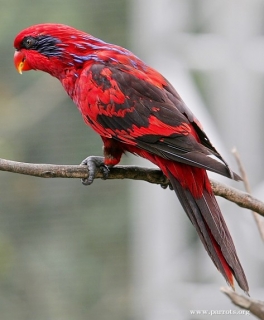Blue-streaked Lory |
|
|
Also known as: Blue-necked Lory
Photos
View in GalleryDid You Know?
Lories and lorikeets have specialized tongues for feeding on nectar. Tiny hair-like projections called papillae form a U-shape on the end of the tongue, which the birds use to soak up the nectar.Academic Research
Related publications: Eos reticulataSpecies Profile
Genus: Eos | Species: reticulata
Size:
31cm (12.1 in)
Weight:
145-155g (5.1-5.4 oz)
Subspecies including nominate:
one
Colour Adult:
Both adults in general red plumage; purple/blue stripe from eye across ear coverts to sides of neck; blue/black wash on lower nape to mantle, the feathers streaked purple/blue; red back and rump, the feathers streaked blue; feathers on wing and greater wing coverts red with black tips; brown/black upper tail, dull red under tail. Bill red. Eye orange/red.
Colour Juvenile:
As in adults but underparts margined with dusty black/blue; blue mottling on mantle replacing streaking. Bill brown/orange. Eye brown.
Call:
Calls may be prolonged, nasal and screechy or a set of screeches strung together. Also notes that recall that of starlings’ chatters and whistles.
Video Links:
Video 1 | Video 2More Information:
Content Sources:
CITES
BirdLife International
Cornell Lab of Ornithology/Birds of the World
Parrots: A Guide to Parrots of the World, Juniper and Parr, 1998
Article "Lories and Lorikeets" by Dick Schroeder
Parrots: Status Survey and Conservation Plan 2000-2004, Snyder, McGowan, Gilardi and Grajal, 2000.
Parrots of the World, Forshaw and Cooper, 1977. 2010 edition
Lexicon of Parrots, Thomas Arndt.
Parrots of the World, Forshaw, 2006.
Parrots in Aviculture, Low, 1992.
Photos
View in GalleryDid You Know?
Lories and lorikeets have specialized tongues for feeding on nectar. Tiny hair-like projections called papillae form a U-shape on the end of the tongue, which the birds use to soak up the nectar.Academic Research
Related publications: Eos reticulataSpecies Care
Captive Status:
Uncommon
Longevity:
28-32 yrs
Housing:
Enclosure with well drained concrete or tile floor, or suspended aviary over same.
Diet:
Commercial lory nectar or homemade mixture with baby cereal (lactose free), honey and malt extract or molasses, mixed with filtered water, made fresh once or twice daily, with wheat germ cereal if desired; fruit such as: apple, pear, bananas, oranges, cactus fruits; and one or more of vegetables such as: carrot, corn on the cob or tinned (unsalted) sweet corn; green leaves such as: Swiss chard, lettuce, dandelion, chickweed; rearing food made from hard-boiled egg, wholegrain bread and carrot, all ground to crumbly consistency.
Enrichment:
Socialization, bathing.
Nest Box Size:
Vertical box 8" x 8" x 12" (20.3cm x 20.3cm x 30.5cm).
Clutch Size:
2
Incubation Time:
25 days
Fledging Age:
12 weeks
Hatch Weight:
Not recorded.
Peak Weight:
Not recorded.
Weaning Weight:
Not recorded.
Specialist Club:
Photos
View in GalleryDid You Know?
Lories and lorikeets have specialized tongues for feeding on nectar. Tiny hair-like projections called papillae form a U-shape on the end of the tongue, which the birds use to soak up the nectar.Academic Research
Related publications: Eos reticulataSpecies Wild Status
World Population:
100,000-500,000
IUCN Red List Status:
Near Threatened
CITES Listing:
Appendix II
Threat Summary:
A BirdLife “restricted-range” species. Locally abundant, but trapping for trade is heavy; past trade saw over 3000 birds a year enter the international market. Also threatened by moderate habitat destruction.
Range:
Found on Yamdena and Larat, Tanimbar Islands and Babar Island, Indonesia. Introduced to Kai Islands and Damar Island, where it has possibly disappeared.
Habitat:
Occurs in mangroves, coconut groves, plantations and secondary forest along the coast; also primary forest.
Wild Diet:
Has been seen visiting Sago and coconut palms.
Ecology and Behaviour:
Habits are similar to those of other Eos species. Usually seen in flying flocks of ten or more birds; flocks are often noisy. When seen singly or in pairs are more shy.
Clutch and Egg Size:
2 rounded eggs, 29.0 x 23.0mm (1.1 x 0.9 in)
Breeding Season:
Not recorded.
Related Links:
Wikipedia
Research: The conservation status of Tanimbar Corella and Blue-streaked Lory...
Photos
View in GalleryDid You Know?
Lories and lorikeets have specialized tongues for feeding on nectar. Tiny hair-like projections called papillae form a U-shape on the end of the tongue, which the birds use to soak up the nectar.Academic Research
Related publications: Eos reticulataMembers Only Resources
Please log-in now to find more research, resources and tools.
Not a Member?
Find more great information:
Gain exclusive access to 600+ pages of additional research, seminars and podcasts, specialists to ask your toughest questions, and dozens of other fun resources - when you become a WPT member.
Join Today >>

































